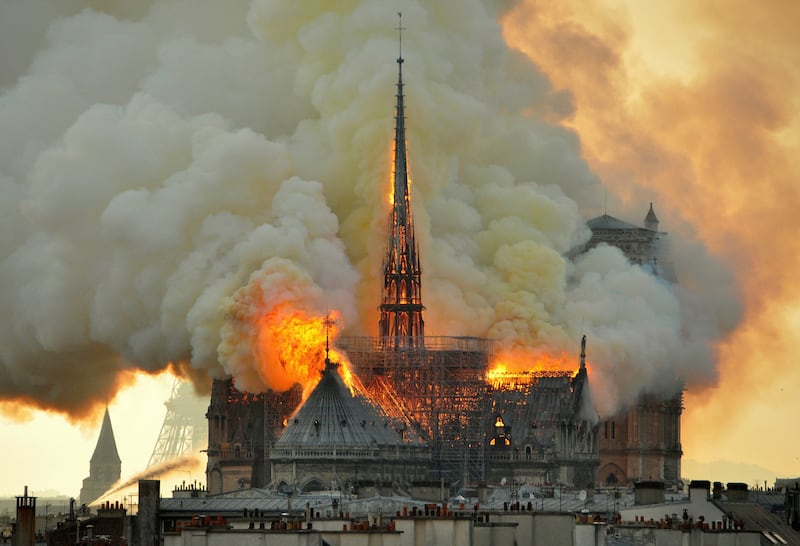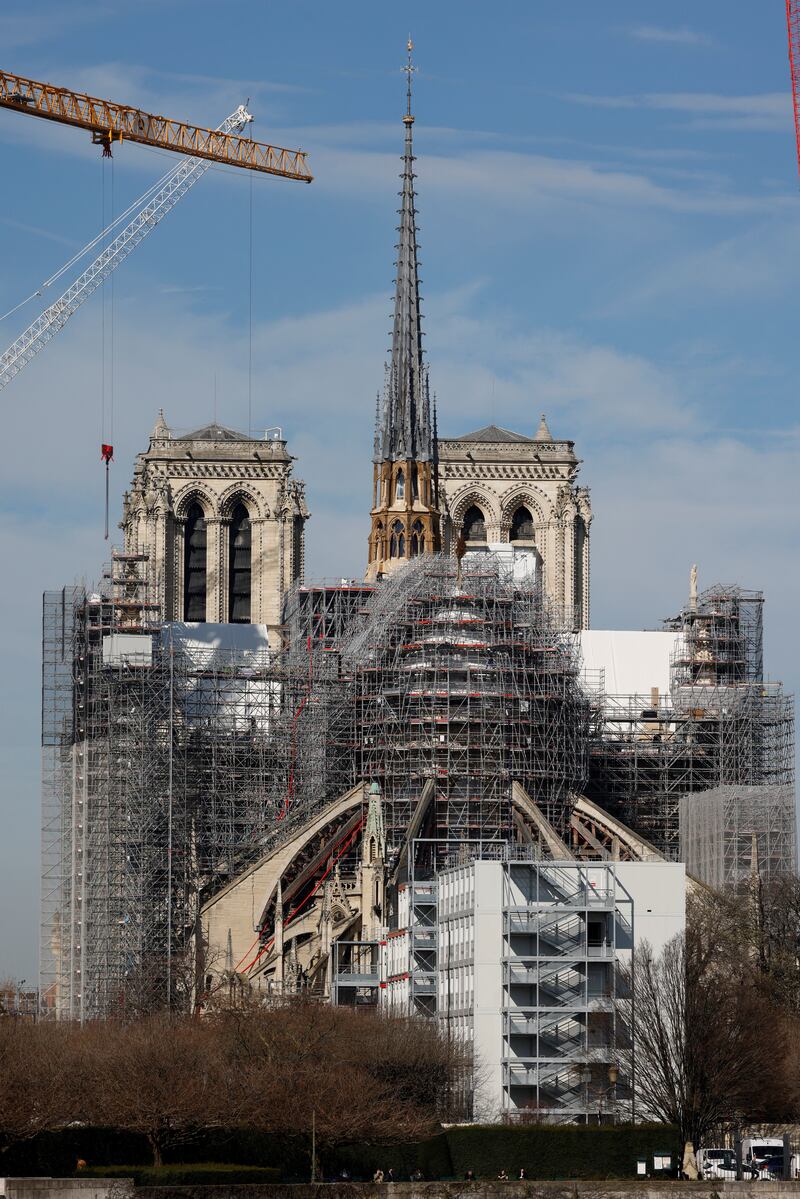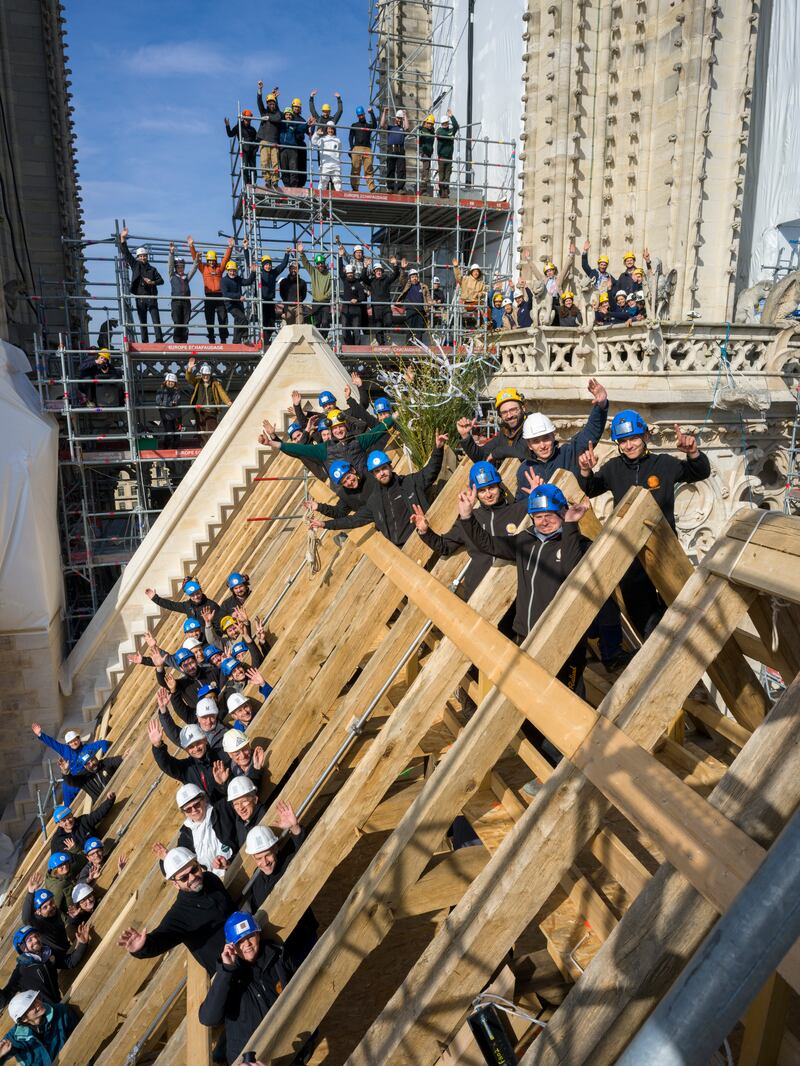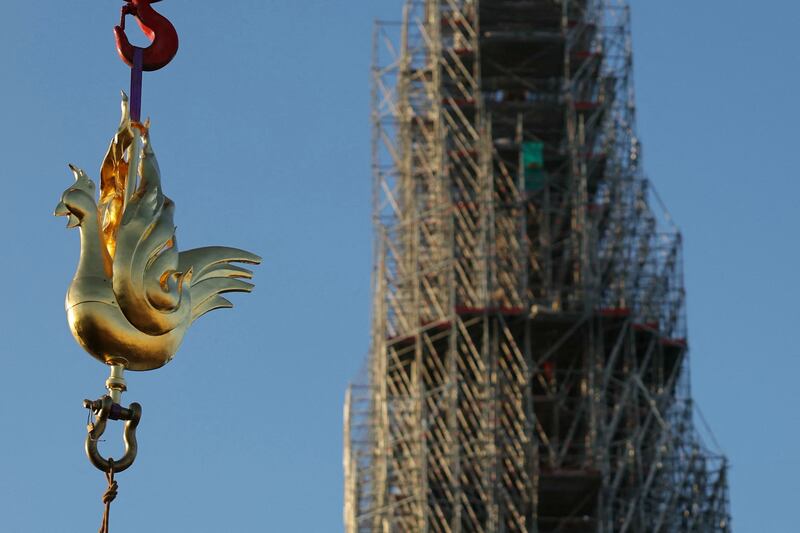The fire at Notre-Dame was without doubt the most shocking event I’ve ever witnessed. Especially as I had been in the great Gothic cathedral earlier that day – almost exactly five years ago, on April 15th, 2019 – with my brother Liam and his extended family, most of whom were visiting Paris for the first time. When the awful news came through that evening we could barely believe it. By the time we got to Quai de l’Hôtel de Ville a devastating fire had taken hold. Dense clouds of smoke were billowing from the cathedral, where the central spire had just collapsed, and the entire roof was in flames, glowing brightly in the dusk.
As I recalled in an article in The Irish Times five days later, thousands of people had gathered along the quays of the Seine, a few kneeling in prayer and some singing hymns, perhaps hoping for a miracle, as police sirens wailed incessantly and the fire service – the Brigade de sapeurs-pompiers de Paris – fought valiantly to quell the blaze with power hoses.
[ Frank McDonald: I was a visitor to Notre Dame the day it blazedOpens in new window ]
For a time it looked as if they were losing the battle, as we could see flames leaping into the cathedral’s north tower, where eight of its 21 bronze bells are located; if the fire took hold there it could have brought them down and possibly even the tower. Only when it became clear that this grave danger had been averted did we feel confident enough to leave.
As the fire was dying down a cartoon went viral on Instagram. Drawn by the Ecuadoran architect Cristina Correa Freile, it depicted a grief-stricken Quasimodo, the legendary hunchbacked bell-ringer, cradling the cathedral’s twin towers. “The world embraces Notre-Dame right now,” she wrote. I cried when I first saw it, and I’m sure many others did too.
Within 24 hours some of the richest people in France – Bernard Arnault, head of the LVMH luxury-goods conglomerate; François-Henri Pinault, whose Kering group runs a stable of fashion brands, Balenciaga, Gucci and Saint Laurent among them; and the Bettencourt Meyers family, owners of L’Oréal – pledged to donate a total of €500 million towards the restoration of Notre-Dame.

In a televised address from the Elysée Palace, President Emmanuel Macron pledged: “We will rebuild the cathedral of Notre-Dame, even more beautifully, and I want it done within the next five years” – in time for this summer’s Paris Olympics. It seemed like a wildly optimistic timetable given the immensely complex restoration task facing France.
Although the cathedral’s great organ, priceless treasures and rose windows were miraculously saved from the fire, the 13th-century oak roof trusses of its attic – known as la Forêt, or the Forest – were consumed by it. And when the 96-metre spire tumbled into the nave like a huge blazing shard it brought down a large section of stone vaulting at the transept crossing.
Ironically, a programme of restoration work was under way around the spire when the fire started – apparently due to an electrical shortcircuit or someone not extinguishing a cigarette. While the steel scaffolding erected to facilitate this work survived the inferno, it was in a parlous state – as were the coping stones on top of its walls, as well as the north, south and west gables.
Urgent actions to secure the building began the day after the fire, following a visual inspection by Philippe Villeneuve, chief architect for historic monuments in the Paris region. These included stabilising the gables with timber props for lateral support, as well as bringing in mountain climbers to stretch tarpaulins over the exposed nave, choir and transepts for protection from the weather.
Given that the surviving stone vaults were saturated with water from firemen’s hoses, 40 sensors connected to alarms were installed to monitor any structural movement down to the nearest millimetre. Statues on the gables were also taken down as a precautionary measure and nets put in place to guard against the risk of falling masonry; it was that serious.

Macron appointed a retired French army general, Jean-Louis Georgelin, as his special representative to oversee the restoration project; sadly, he died in August 2023 after a hiking accident in the Pyrenees. Georgelin was succeeded as director of the new public institution, Rebâtir Notre-Dame de Paris, or Rebuilding Notre-Dame de Paris, by Philippe Jost, a former armaments engineer and senior civil servant.
Intense controversy erupted over Macron’s proposal for an international competition to design a new spire as a “contemporary architectural gesture” in restoring the cathedral. Villeneuve threatened to resign if this was done, the French senate passed a bill requiring that reconstruction be faithful to its “last known visual state”, and the president relented.
The spire wasn’t even original; it was designed by the French medievalist architect Eugène Viollet-le-Duc as part of his restoration of Notre-Dame in the 1850s. But the form of his spire had imprinted itself in the public mind as an integral element of the cathedral. Fortunately, its set of 16 copper statues survived the fire as they had been taken down just a few days earlier.
Oak needed to create a replica of the spire was sourced in the old royal forest of Bercé, south of Le Mans, where the selected trees, all at least 18m tall, had been planted during the reign of Louis XIV to provide masts for French naval vessels. A thousand sturdy oaks needed to replace the roof trusses were donated by forests all over France, in solidarity with Paris.
It would have been so easy to specify steel trusses, but the desire for authenticity dictated not only the choice of natural oak but also that the wood should be worked in the same way that medieval carpenters would have done, employing axes and adzes, with dowels to hold pieces together rather than nails or screws. This is even more remarkable given the extremely tight timetable.
The roof had been covered in cast lead sheeting and the spire in moulded lead, all of which – amounting to 460 tonnes – turned molten in the fire, scattering toxic dust everywhere. Lead levels reached up to 500,000 microgrammes per square metre in the immediate vicinity of the cathedral – 100 times the maximum permitted level – and also contaminated the surrounding area.

The environmental campaign group Robin des Bois took legal action against the authorities for failing to protect the health of workers on the site and nearby residents following the fire. This resulted in a month-long shutdown while the cathedral was decontaminated by a crew in hazmat suits that became compulsory for everyone entering the site until it was made safe.
First the cathedral’s interior was cleaned with high-powered vacuum cleaners with filters to catch lead particles. Then a latex vapour was sprayed on the walls, including sculpted elements. After this vapour hardened to form a layer that captured any remaining dust, as well as centuries-old grime, the latex coating was peeled off to reveal the bright sand-coloured limestone.
A large quantity of the same Lutetian limestone – 1,300 cubic metres – was needed to reconstruct the collapsed vaults, replace the damaged coping stones and carve new decorative elements. All of this was sourced from a single quarry at Bonneuil-en-Valois, 70km northeast of Paris, and brought to the workshops in large blocks for stonemasons to cut and shape.
As in the medieval era a “sculptors’ lodge” was set up outside the cathedral for the team of craftspeople carving or recarving statues, gargoyles and other ornamental pieces. Major carpentry and joinery work was done off site, with cranes used to lift the new oak trusses into position. Altogether 150 companies are involved, with a workforce of 500 on site most of the time.

“France is uniquely prepared to take on such a delicate, complex, globally important project,” says Maeve Jennings, from Kells, Co Meath, who has been living in Paris for 22 years. “The building site is a town of craftspeople and restorers who are so proud to be working on it. Even the scaffolding is amazing, lit up at night like a crazy cruise ship in the middle of the Seine.
“Making beautiful things is what Paris does better than anywhere in the world, and Parisians know it, so there is great confidence and pride in this project, a real sense of ownership,” says Jennings, who is on the board of Fondation Irlandaise and the Irish Cultural Centre’s strategy committee. “And because it’s the heart of the city we all see it progress from day to day or week to week.
“France has always had systems in place to ensure the handing down of craft skills from generation to generation through guild-like associations such as Compagnons du Devoir and Meilleurs Ouvriers de France. Even the bureaucracy of the approvals system for major projects in Paris will ensure a world-class restoration and protect the process of achieving it.
“I think it surprised most Parisians how emotionally connected they are to Notre-Dame, something we all knew was wonderful but had totally taken for granted. They speak of seeing the spire fall in the same way as people recall JFK’s assassination or 9/11. Parisians are not given to showing their softer side, but they were weeping openly in the streets, in shared trauma and grief.”


When the bells were rung for the first time since the fire, to mark the Epiphany on January 6th this year, and even more so when the replica spire was pieced together and then stripped of scaffolding before the end of March, “it was balm for the city’s soul, and we needed that after what had happened to Notre-Dame and the horrifying Charlie Hebdo and Bataclan massacres in 2015.″
A new phoenix-like golden cockerel weathervane that tops the spire – designed by Philippe Villeneuve as a symbol of the cathedral’s “resurrection” – was blessed by the archbishop of Paris, Laurent Ulrich, before it was levered into position last December. And to guard against a future fire the oak “forest” in its attic has been fitted with a misting system to quench any outbreak.
Notre-Dame’s “voice”, its incomparable great organ, is also being restored. The largest in France, with 8,000 pipes, five keyboards and 109 stops, it was also contaminated by lead dust and needed to be dismantled for deep cleaning before being reassembled, piece by piece, with its old sheepskin bellows replaced by new ones, and finally tuned to a new level of perfection.


Regrettably it proved impossible to organise a visit to the cathedral before the fifth anniversary of the fire – Rebâtir Notre-Dame de Paris cited scheduling constraints – but there is an immersive interior exhibition on the square in front of it, as well as an excellent outdoor display illustrating what has been happening, on large panels around the perimeter.
Work on the site is set to continue long after the cathedral’s scheduled reopening, on December 8th, the feast of the Immaculate Conception. This includes a separate €50 million project, financed by Paris city council, to transform the surroundings of Notre-Dame in line with a superb climate-friendly competition-winning scheme by the Brussels-based landscape architect Bas Smets.
Although still encased by an exoskeleton of steel scaffolding, the cathedral’s thoroughly cleaned and fully restored interior will come as a complete revelation – pristine limestone walls, stained-glass windows more luminous than ever, painted chapels and funerary monuments gleaming, woodwork in the choir stalls and elsewhere looking as good as new. All done and dusted.
By any measure the speedy restoration of the cathedral is an extraordinary achievement that is bound to be seen as Macron’s most enduring legacy. It has also stirred the hearts of people everywhere. Some 340,000 donors from more than 150 countries – including French billionaires – have contributed a total of €846 million towards the cost of this heroic project.
Like all of the cathedrals in France, Notre-Dame de Paris may be owned by the French state, but it truly belongs to the world, now more than ever.











